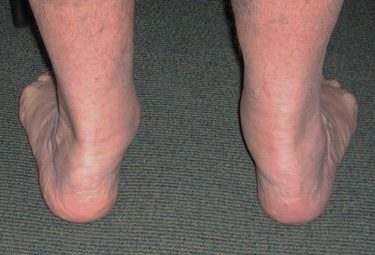Millions of children and adults have flat feet. Some can walk and function very well, but others have various degrees of discomfort and pain. Their ability to walk, run, stand, play, and work is compromised by the severity of their foot problem.
Genetics are the blueprints of the body. Painful foot and ankle problems frequently run in families. When one or both of the parents have foot problems, the likelihood that their children will have foot problems dramatically increases. When a child inherits the worst genes from both parents, they may develop a flatfoot deformity that is far worse than either parent.
Examination of flat feet reveals abnormal alignment problems with the foot, the ankle, and the lower leg. Excessive flexibility with the joints in the foot accounts for the term flexible flatfoot deformity. When a flatfoot is not flexible, the term rigid flatfoot deformity is assigned. The flexible flatfoot may appear to have a normal arch lying in bed, but the arch quickly flattens whenever bodyweight pressure is applied to the foot with each step. The healthy foot and ankle must function as a stable tripod. If one were to draw a line from the heel to the big toe, from the big toe to the small toe, and back to the heel, this would form the triangular weight-bearing surface of the tripod. The ankle and the leg balance on top of this tripod. A stable tripod allows the leg to remain vertical and the ankle joint to remain parallel to the ground. When the foot cannot support the ankle and the leg, compensatory stress develops in the foot, ankle, knee, hip, and lower back. Over time, arthritis and pain develop leading to disability.
Flatfoot Treatment has vastly improved over the years. Mild and moderate cases respond well to custom-made orthotic devices.
An orthotic is a custom-designed shoe insert for the foot that is created from all three of the following:
1.) a non-weight-bearing, corrected cast mold of each foot,
2.) a biomechanical examination of each foot.
3.) a tailored orthotic prescription for each foot.
These 3 factors determine a comfortable, functionally supportive to your weight, custom-made orthotic insert. A properly made orthotic should alleviate pain, realign, and stabilize the foot, the ankle, the leg, the hip, and the spine of children and adults. When orthotic control is not sufficient to stop the pain, then surgical options become necessary. In severe cases, children and adults are unable to work or play without pain in their feet and ankles. In extreme cases, merely walking across their bedroom floor brings tears to their eyes.
Many surgical procedures, over the last 100 years, emerged to address the flatfoot deformity. Unfortunately, each procedure initially viewed itself as the cure for all flatfoot problems. As a result, sometimes they worked, but many times they did not. The current high rate of success in treating flatfeet requires incorporating multiple flatfoot procedures together. Stabilizing each weakness or component ( i.e.; forefoot, mid-foot, Rearfoot, and ankle) of the individual’s flatfoot deformity allows the stable foot and ankle to emerge.
COMMON SURGICAL PROCEDURES FOR FLAT FEET:
- CALCANEAL SLIDE OSTEOTOMY: used to correct a + Helbing sign, which moves the heel bone under the center of the leg to properly accept the balanced weight of the leg.
- EVANS OSTEOTOMY WITH BONE GRAFT: used to reduce the “duck foot” shape of the foot and straighten the outside alignment of the foot.
- KIDNER WITH POSTERIOR TIBIAL TENDON REPAIR: used to repair and strengthen the tendons and ligaments on the inside arch.
- COTTON OSTEOTOMY WITH BONE GRAFT: used to bring the big toe joint back down to the ground and support the medial column of the foot.
- TAL OR GASTROCNEMIUS RECESSION: used to address ankle equinus ( inability to adequately dorsiflex the ankle).
For an appointment call 708-867-3338 or (630)-582-1100. We will adjust our hours for the convenience of our patients, whenever possible. We can make your feet smile again!
Open: Mon.- Sat. & Evenings by appointment only.
AFP Podiatry, LTD
825 N. ROSELLE RD. ROSELLE, IL. 60172
Phone: (630) 582-1100
or
AFP Podiatry LTD. 4701 N. Cumberland Ave. Suite 19 Norridge, Il. 60706 Phone: (708)-867-3338






